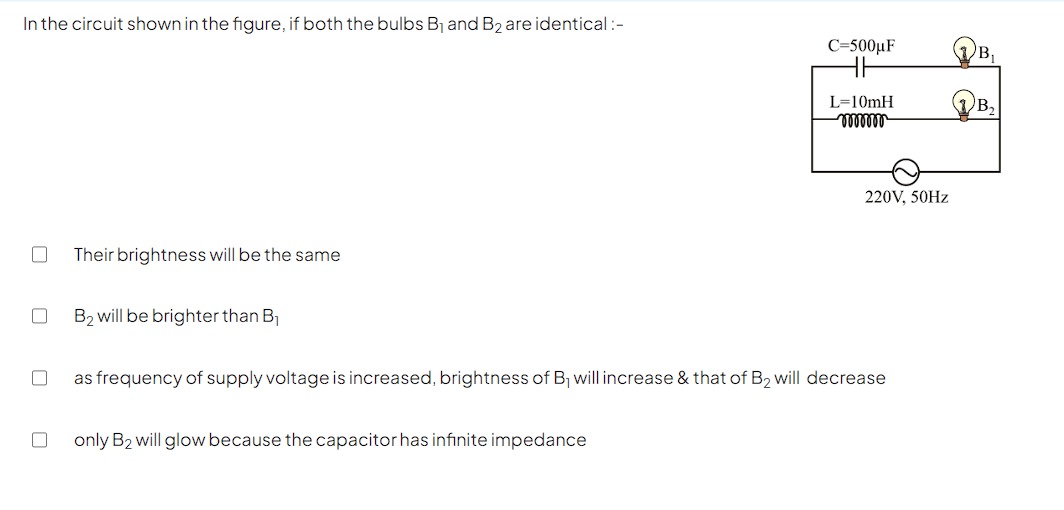Question
Question: In the circuit shown in the figure, if both the bulbs B₁ and B₂ are identical :- ...
In the circuit shown in the figure, if both the bulbs B₁ and B₂ are identical :-

Their brightness will be the same
B₂ will be brighter than B₁
as frequency of supply voltage is increased, brightness of B₁ will increase & that of B₂ will decrease
only B₂ will glow because the capacitor has infinite impedance
B₂ will be brighter than B₁
Solution
The circuit consists of an AC voltage source connected to two parallel branches. One branch contains a bulb B₁ in series with a capacitor C. The other branch contains a bulb B₂ in series with an inductor L. Both bulbs are identical, meaning they have the same resistance R. The brightness of a bulb is proportional to the power dissipated by it, which is given by P=Irms2R. Since R is the same for both bulbs, the brightness is proportional to the square of the RMS current flowing through the bulb.
The RMS voltage of the source is Vrms=220V and the frequency is f=50Hz. The angular frequency is ω=2πf=2π(50)=100πrad/s. The capacitance is C=500μF=500×10−6F=5×10−4F. The inductance is L=10mH=10×10−3H=10−2H.
The impedance of the branch containing bulb B₁ and capacitor C is Z1=R+jXC, where XC=ωC1 is the capacitive reactance. The magnitude of the impedance is ∣Z1∣=R2+XC2. The RMS current through bulb B₁ is I1,rms=∣Z1∣Vrms=R2+XC2Vrms.
The impedance of the branch containing bulb B₂ and inductor L is Z2=R+jXL, where XL=ωL is the inductive reactance. The magnitude of the impedance is ∣Z2∣=R2+XL2. The RMS current through bulb B₂ is I2,rms=∣Z2∣Vrms=R2+XL2Vrms.
Let's calculate the reactances at f=50Hz: XC=ωC1=(100π)(5×10−4)1=5π×10−21=5π100=π20≈6.366Ω. XL=ωL=(100π)(10−2)=πΩ≈3.142Ω.
Comparing the reactances, we have XC>XL. Since XC>XL, we have R2+XC2>R2+XL2, which means ∣Z1∣>∣Z2∣. Since the voltage across both parallel branches is the same (Vrms), the current through the branch with lower impedance will be higher. Thus, I1,rms=∣Z1∣Vrms<∣Z2∣Vrms=I2,rms. Since I1,rms<I2,rms, the power dissipated by B₁ will be less than the power dissipated by B₂, and hence B₁ will be less bright than B₂. So, B₂ will be brighter than B₁.
